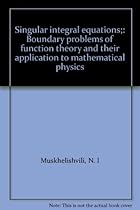Singular integral equations;: Boundary problems of function theory and their application to mathematical physics

| Author | : | |
| Rating | : | 4.98 (889 Votes) |
| Asin | : | B0007JM5W0 |
| Format Type | : | paperback |
| Number of Pages | : | 447 Pages |
| Publish Date | : | 0000-00-00 |
| Language | : | English |
DESCRIPTION:
Language Notes Text: English (translation) Original Language: Russian
Intended for graduate students, applied and pure mathematicians, engineers, physicists, and researchers in a variety of scientific and industrial fields, this text is accessible to students acquainted with the basic theory of functions of a complex variable and the theory of Fredholm integral equations.. Its coverage includes such topics as the Hölder condition, Hilbert and Riemann-Hilbert problems, the Dirichlet problem, inversion formulas for arcs, and many other areas. They are highly effective in solving boundary problems occurring in the theory of functions of a complex variable, potential theory, the theory of elasticity, and the theory of fluid mechanics.This high-level treatment by a noted mathematician considers one-dimensional singular integral equations involving Cauchy principal values. Singu
One of the finest on complex boundary value problems. Eventhough this text dates from 19One of the finest on complex boundary value problems. Bernardo Vargas Eventhough this text dates from 1946 it is difficult to find a more complete and accurate discussion on the boundary value problems raised up by the Cauchy integral.Being one of the most outstanding pupils of the Vekua school (as Gakhov), Muskhelishvili explores every single particular case of the classical boun. 6 it is difficult to find a more complete and accurate discussion on the boundary value problems raised up by the Cauchy integral.Being one of the most outstanding pupils of the Vekua school (as Gakhov), Muskhelishvili explores every single particular case of the classical boun. "A great aid" according to Massimiliano Celaschi. To be honest, I have not gone into a thourough and complete reading of the texbook, but I picked up several and sparse subjects in order to get a better understanding about some issues relating linear transport theory. But also in a limited use like that I cannot help recognizing that, even after half a century,
